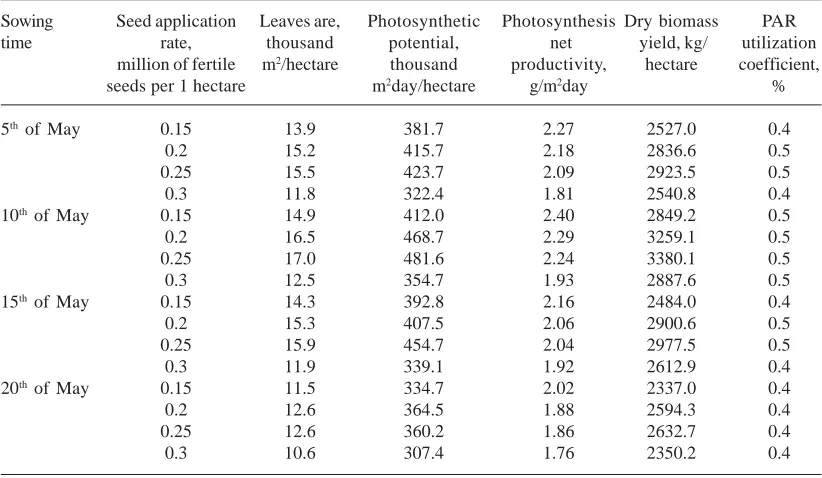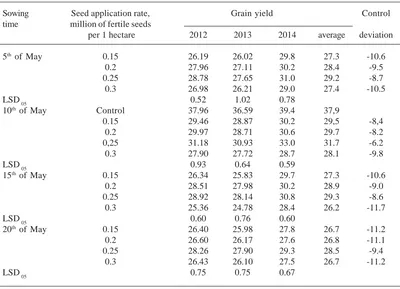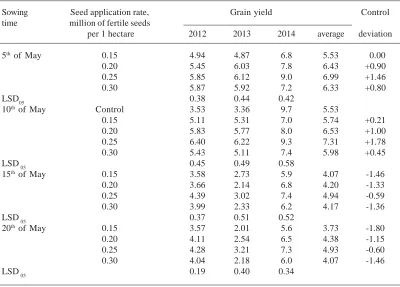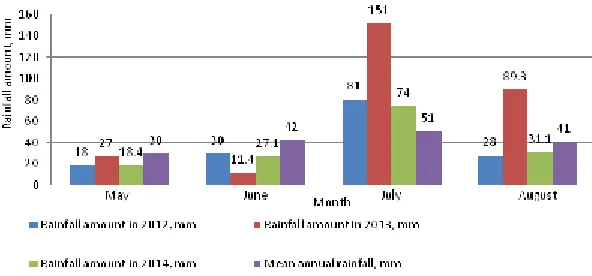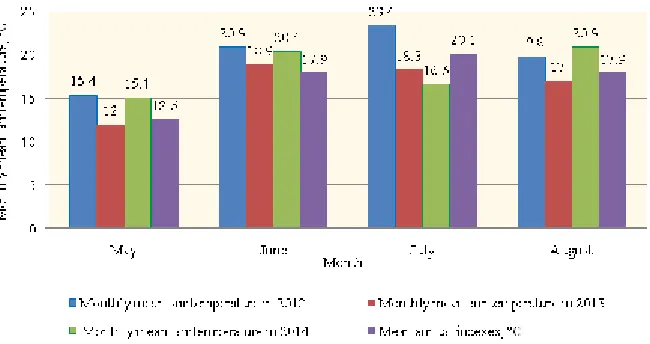BIOSCIENCES BIOTECHNOLOGY RESEARCH ASIA,December 2014. Vol. 11(3), 1121-1130
* To whom all correspondence should be addressed. E-mail: utelbaev_erlan@mail.eu
Producing Capacity of Safflower on Dark
Brown Soils of the Northern Kazakhstan
Mussynov Kazhymurat Mayrambekovich,
Kipshakbaeva Asemgul Amangeldinovna, Arinov Bauyrzhan Kenzhebaevich, Utelbayev Yerlan Amanzholovich and Bazarbayev Berik Bekturevich
S.Seifullin Kazakh Agrotechnical University, Republic of Kazakhstan, 010000 Astana, 62 Pobeda Avenue.
DOI: http://dx.doi.org/10.13005/bbra/1497
(Received: 30 October 2014; accepted: 05 December 2014)
Research results on process development of safflower cultivation for oilseeds under dark brown soil conditions ofthe northern Kazakhstan were presented. Safflower response in yield to heat and moisture availability was determined. Features of yield formation and fat content in safflower seeds depending on sowing time and seeds application rate were researched. Optimum sowing time and seeds application rate were detected during research years. At all sowing times, yield and oil content in safflower seeds were increased with increase of seeding rate from 0.15 to 0.25 million of fertile seeds per 1 hectare, but with further increase in seeding rate, yield and oil content in safflower seeds were decreased. Sowing time 10th of May with seeding rate 0,25 million of
fertile seeds per 1 hectare turned out to be economically advantegeous for years of research.
Key words: Safflower, Sowing time, Seeding rate, Yield, Seeds oil content.
Seed oils and food products based on them became basic in structure of population nutrition in recent years. They present prime raw material element for various types of products of food industry. At present day, Government of Republic of Kazakhstan takes measures on sowing expansion in order to produce enough raw materials for oil manufacture in amount meeting needs, primarily, of domestic market1.In response
to these problems, “Development program for agro-industrial complex in Republic of Kazakhstan for a period of 2010-2014” was implemented by government, challenges included increase of total acres and yield of oil plants2, and also development
program for agro-industrial complex in Republic of Kazakhstan up to 2020 (Agro-business-2020) is
effective and implemented since 2013, where it is stated that the yield of major crops, including oil plants, is on low level compared to world yield indexes, and it is asserted, that main constraining factors for processing industry development are low quality and raw material shortage3.
Climate changes having tendency to temperatures rise, drier and hotter summer, require oil-plants and their sorts’ line extension. List of crops, which may give constant yields, is quite restricted under hard climatic and natural conditions. In this regard, the need for selection and expansion of cultivation area of more draught-tolerant and thermophilic oil plants arises4.
Safflower (Carthamus tinctorius L.) was initially cultivated as dye plant and for cooking. Today, safflower is primarily used for oil, applied for food and technical purposes6. It is minor crop
with world output about 650 000 ton per year7.
Seeds and products processed from these are exported worldwide. Main five manufacturers are India, USA, Mexico, Argentina and Kazakhstan8.
Steady tendency of sowing expansion and increase of oil-crop production is registered in Kazakhstan for last decades9. Safflower may replace
sunflower as oil crop in arid steppe regions. If earlier safflower was cultivated mainly in the Southern regions of Kazakhstan, then now this crop, due to its unprentiosness and draught-tolerant, is sown on more areas in northern regions. Safflower popularity is based on its fit to conditions of sharp continental climate and relates to most draught-tolerant plants5.
In aridity region, key factor of constant yields is reciept of early and even sprouts. In this regard, one of key issues at development of safflower cultivation process is determination of optimum sowing time9.
Upon research results of scientists from Samara agricultural scientific research institute of the Russian Agricultural Academy, safflower is resistant to spring frost and seeds require much moisture for sprouting, so its optimum sowing time is the earliest time along with early spring cereals10.
Some scientists (Aksionov I.V., Zinchenko O.I., Salatenko V.N., Bilonozhko M.A.) recommend to sow safflower in early times11, 12 for arid Ukranian
sreppes, where rainfalls for growing season were on level from 100 mm (1999) to 347 mm (2004). Also upon research results of scientists D. Lyon, P. Burgener (2007), J.L. Helm, N. Riveland (1991), it discovered, that optimum safflower sowing time in West Nebraska and North Dacota (USA) must be considered period from April 20 to May 10 13,14.
According to performed reported analysis, there is no data on development and research of specific agronomic practices for cultivation process of safflower on dark brown soils of the northern Kazakhstan. We were the first to perform integrated researches based on multi-factored experience on finding optimum parameters for safflower cultivation at various sowing time and seed application rate on on dark brown soils of the northern Kazakhstan.
Material and research methods
Field tests were performed on experimental plot of LLC “Farmer 2002”, located in Astrakhan district of Akmola region. Test object was safflower breed Akmai of Kazakhstan selection. Four sowing times were tested: 5, 10, 15 and 20 of May, as well as four seed application rates: 0.15; 0.20; 0.25 and 0.30 million of fertile seeds per 1 hectare. Seeding method is wide row with seed spacing of 45 cm. Cropping to safflower is only wheat after fallow. Pre-sowing treatment of seeds: air-heat warming, sees treatment by tetramethylthiuram disulfide at the rate of 2-3 kg/ ton. Sowing of safflower seeds was performed by seeding machine SZS-2.1. Minimum tillage was applied in tests. After harvesting previous crop and before sowing, tillage was not performed. Harvesting was performs in phase of complete ripeness of all heads by regular combine harvester by direct combining.
Since there are no safflower breeds eligible for sowing in given region, we, by recommendation of scientists from north and south regions of the country, sowed sunflower breed Sochnskiy, which is released for given region and cultivated for oil seeds, as control for comparing of yield and oil content. Optimum sowing time is 10th of May with recommended seeding rate
0.045-0.050 million of fertile seeds per hectare.
While researching, we performed the following monitoring, accounting and analysis: 1. Meteorological condition per data of
weather station of Astrakhan district settlementZhaltyr of Akmola region. 2. Soil moisture was determined by
thermostatic weight method by formula:
where,
W – soil moisture in % from weight of dry soil; m0— weight of aluminium cup, g; m1 – weight of cup with soil before drying, g; m2 – weight of cup with dry soil after drying, g.
Reff = 0.1(W – PWP)dh
where,
Reff is reserve of efficient moisture, mm; d – weight by volume, g/cm3;
h – thickness of analyzed soil layer, cm;
W – soil moisture in % from weight of absolute dry soil;
PWP – permanent wilting point, %;
0.1 – conversion factor of water layer depth from centimeters to mm15.
4. Calculation of hydrothermal index (HTI) was performed by formula proposed by G.T. Selyaninof:
where, “Q – amount of rainfalls
over growing season, mm;
Σt >10C° – sum of air temperatures over 10C° for growing season.
Phenological observations are performed in compliance with the procedure of state strain testing of crops. Observations are performed from sowing to seeds ripening on 4 fixed grounds, plots in size of 0.25 m2 by two nonadjacent replicants16
6. Determination safflower leaves area was performed by method offered by Nurgasenov T.N., Arystangulov S.S., Karakalchev A.S., Tuitenov G.17. Area of
safflower leave surface is calculated in blossoming phase by formula:
S= A × B × K A – leave length, mm;
B – leave major width, mm; C – correction factor.
Correction factor for safflower leaves, regardless of location at plant, upon the average, is equal to 0.707.
7. Photosynthetic potential of leave surface is calculated by common method of A.A. Nichiporovich, 1961:
D L
PP = ×
L – leave surface, thousand m2/hectare;
D – period duration (days).
8. Photosynthesis net productivity (PNP) describes, what amount of absolute dry substance is accumulated on 1 m2 of leave
surface area over 24 hours. Photosynthesis net productivity is calculated by formula offered by Kid, West and Brigs:
PNP – photosynthesis net productivity, g/m2 day;
W2 – yield weight at further determination, g/m2;
W1 - yield weight at further determination, g/m2;
L1 L2 – leaves area at the same period, m2;
D – period duration, days.
9. Utilization coefficient of photosynthetic active radiation (PAR) (Qpar) for sowing is calculated by formula:
where:
Qpar – utilization coefficient of PAR(efficiency factor);
Y – crop yield of dry biomass, kg/hectare; C – caloric value of dry substance, kJ/kg of dry biomass;
Qpar– PAR input over crop growing season, kJ/ hectare18.
10. Accounting of crop yield was maintained by combine harvesters with re-count on 100 purity and 12% moisture, combine harvester Yenisei – 1200.
11. Oil content in safflower seeds is determined by standard method in biological chemistry laboratory of Kazakh by A.I. Barayev research institute for grain farming. 12. Economic effectiveness is calculated on the
base of flow charts with correcting of actually performed agro-measures. 13. Obtained crop yield results and oil content
in safflower seeds were processed by program SNEDECOR19
RESULTS AND DISCUSSION
According to the data of agrochemical survey, performed in 2012, soil of experimental field is dark brown carbonated medium deep. Humus level is 3.0%, easy hydrolysable nitrogen is 36.8 mg/kg of soil; P2O5 – 19.4 mg/hectare and κ2O – 509 mg/kg.
Table 1. Main indexes for safflower plants photosynthetic activity, average values for 2012-2014
Sowing Seed application Leaves are, Photosynthetic Photosynthesis Dry biomass PAR
time rate, thousand potential, net yield, kg/ utilization
million of fertile m2/hectare thousand productivity, hectare coefficient,
seeds per 1 hectare m2day/hectare g/m2day %
5th of May 0.15 13.9 381.7 2.27 2527.0 0.4
0.2 15.2 415.7 2.18 2836.6 0.5
0.25 15.5 423.7 2.09 2923.5 0.5
0.3 11.8 322.4 1.81 2540.8 0.4
10th of May 0.15 14.9 412.0 2.40 2849.2 0.5
0.2 16.5 468.7 2.29 3259.1 0.5
0.25 17.0 481.6 2.24 3380.1 0.5
0.3 12.5 354.7 1.93 2887.6 0.5
15th of May 0.15 14.3 392.8 2.16 2484.0 0.4
0.2 15.3 407.5 2.06 2900.6 0.5
0.25 15.9 454.7 2.04 2977.5 0.5
0.3 11.9 339.1 1.92 2612.9 0.4
20th of May 0.15 11.5 334.7 2.02 2337.0 0.4
0.2 12.6 364.5 1.88 2594.3 0.4
0.25 12.6 360.2 1.86 2632.7 0.4
0.3 10.6 307.4 1.76 2350.2 0.4
July and early August. There was no rainfall at the second decade of July in period of most moisture requirement (flower-bud formation). That year is described as greatly arid by hydrothermic index (HTI = 0.6).
Growing season of 2013 was abnormal for moisture availability just the opposite to 2012. Rainfall for safflower growing season in 2013 was 278,7 mm, which was higher than mean annual rainfall on 114.7 mm. Amount of rainfall in May was on mean annual level. Main rainfall amount was at II and III decades of July. That period is described as wetted (HTI = 1,3), however, within period from sprout to budding, it was on level 0.3-0.6, that corresponds to assessment scale as very arid.
Rainfall amount was below standard in May, June and August of 2014, only in III decade of June, rainfall was within standard range 24 mm. There was much rainfall in I and III decades of July; 34 and 36 mm. Hydrothermal index (HTI) within period “sowing – ripening” is assessed as arid” – 0.7, however, within period “sprouts-flower-bud formation” this index was0.5-0.6, which complies with assessment scale as very arid (figure 1).
Monthly mean air temperature was higher mean annual data in 2012 and it made up in May: + 15.40C, June: + 20.90C, July: + 23.40C and August: +
19.80C. Sum of active temperatures over 2012
growing season was 2163.1- 2273.2 0C, that was
within standard for safflower.
Monthly mean air temperature in May, July and August was lower on 0.6, 1.8, 0.9 and exceeded on 1.0 °C in June in 2013. Sum of active temperatures was within standard in initial stage of safflower growth, however, at next periods, it was inadequate. Based on analysis of air temperatures in 2013, we concluded, that temperature condition was unfavourable for period of intensive growth of vegetative and genesic parts of safflower plant, more precisely plants were on short supply of warmth, that subsequently effected on formation and work of safflower leave apparatus, especially it is reflected negatively in later sowing times 15th and 20th of May.
Table 3. Oil content in safflower seeds in research years, %
Sowing Seed application rate, Grain yield Control
time million of fertile seeds
per 1 hectare 2012 2013 2014 average deviation
5th of May 0.15 26.19 26.02 29.8 27.3 -10.6
0.2 27.96 27.11 30.2 28.4 -9.5
0.25 28.78 27.65 31.0 29.2 -8.7
0.3 26.98 26.21 29.0 27.4 -10.5
LSD 05 0.52 1.02 0.78
10th of May Control 37.96 36.59 39.4 37,9
0.15 29.46 28.87 30.2 29,5 -8,4
0.2 29.97 28.71 30.6 29.7 -8.2
0,25 31.18 30.93 33.0 31.7 -6.2
0.3 27.90 27.72 28.7 28.1 -9.8
LSD 05 0.93 0.64 0.59
15th of May 0.15 26.34 25.83 29.7 27.3 -10.6
0.2 28.51 27.98 30.2 28.9 -9.0
0.25 28.92 28.14 30.8 29.3 -8.6
0.3 25.36 24.78 28.4 26.2 -11.7
LSD 05 0.60 0.76 0.60
20th of May 0.15 26.40 25.98 27.8 26.7 -11.2
0.2 26.60 26.17 27.6 26.8 -11.1
0.25 28.26 27.90 29.3 28.5 -9.4
0.3 26.43 26.10 27.5 26.7 -11.2
LSD 05 0.75 0.75 0.67
heat in blossoming period for seeds formation and ripening (figure 2).
Reserves of efficient moisture in one meter soil layer were determined by weather condition and sowing times to a greate degree, difference in given index between researched variants by seed application rates was insignificant. Over the course of surveillance over soil moisture dynamics on safflower crops, moisture decrease was detected from sowing to harvesting in 2012, and that tendency was observed only up to the stage of flower-bud formation. Reserves of efficient moisture increased in the stage of flowering due to great rainfall amount in that period. Reserves of efficient moisture in one meter soil layer before sowing in 2012 were 88, 78 and 89 mm at sowing times May 5, 10 and 15 respectively, and at sowing on 20th of May, they were close to suitable 66 mm.
Moisture reserves reduction to critical values was marked in interstage period “flower-bud formation – flowering” in 2012 at all sowing times. Reserves of efficient moisture were fully expended by yield harvesting time.
2013 appeared a well wetted year, reserves
of efficient moisture in one meter soil layer before sowing were 141.8 and 109.8 mm at sowing times May 5 and 10 respectively, and and at sowing on 15th and 20th of May – 84.8 and 70.9 mm. Moisture
reserves reduction to critical values was not marked in 2013.
Reserves of accessible moisture at sowing time 5th of May were 131.0 mm and
corresponded to high moisture content in 2014; May 10, 15 and 20 were respectively 99; 96 and 88 mm and corresponded to low moisture content. Moisture reserves reduction to critical values was marked in 2014 at the end of vegetation (seeds ripening period) 2.8 mm. High temperature condition and eumorphic safflower herbage contributed to it.
For determination of water consumption by safflower depending on researched agricultural methods, we calculated water-use ratio. The following consistent pattern is detected: with increase of seeds application rate, water-use ratio was reducing regardless to sowing time. That index in variants with sowing time 15th and 20th of May
and 10th of May.
Beginning of main phenological stages of safflower growth in research years depended both on studied agronomic practices and weather conditions. On late time sowings, onset of interstage periods, starting with stage “flowering – ripening”, took place 3-5 days earlier than on early time sowings. Growing season length on early time sowings compiled 119-123 days in 2012, at late time sowings – 114-119 days. Due to ample quantity of rainfall and shortage of warm weather, growing season length in 2013 was on 4-7 days longer when compared to 2012 and on 2-3 days when compared to 2014.
Sprouts density was approximately on one level of 10-20 pcs/m2 with some lowering at
early time of sowing in our researches at wholly suitable soil moisture (when reserve of efficient moisture in 10 cm soil layer was over 15 mm). That index varied on average depending on studied agronomic for research years and compiled 64.0-78.7%; at that, field germination rate increase was observed at late-time sowings.
One of plant active parts is a leave. It
synthesizes organic matters in photosynthesis process, which participate in plant’s forming up and in all chemical conversions. K.A. Timiryazev considered green leave as main plant’s laboratory, where most significant organic matters, composing over 90 % of yield, are created for its life. The more green leaf area plant has, the more energetic accumulation of organic matters takes place and final yield is higher. Increase of sun energy use efficiency in photosunthesis may be performed by placing plants at optimal distance from each other. Significant part of light disappears in vain in widely spaced crops, and condensed plants shade each other, their stems become longer and breakable, easily falling over from rain and wind. Yield reduction takes place in both cases. That is why it is important to select optimum distance for each crop20.
Leave area was formed on the average level of 10.6-17.0 thousand m2/hectare in our tests
for research years. This index regardless to sowing times at increase of sowing rate up to 0.25 million of fertile seeds per 1 hectare is increasing, and at subsequent increase up to 0.3 million of fertile seeds
Table 2. Safflower yield in research years, centner/hectare
Sowing Seed application rate, Grain yield Control
time million of fertile seeds
per 1 hectare 2012 2013 2014 average deviation
5th of May 0.15 4.94 4.87 6.8 5.53 0.00
0.20 5.45 6.03 7.8 6.43 +0.90
0.25 5.85 6.12 9.0 6.99 +1.46
0.30 5.87 5.92 7.2 6.33 +0.80
LSD05 0.38 0.44 0.42
10th of May Control 3.53 3.36 9.7 5.53
0.15 5.11 5.31 7.0 5.74 +0.21
0.20 5.83 5.77 8.0 6.53 +1.00
0.25 6.40 6.22 9.3 7.31 +1.78
0.30 5.43 5.11 7.4 5.98 +0.45
LSD 05 0.45 0.49 0.58
15th of May 0.15 3.58 2.73 5.9 4.07 -1.46
0.20 3.66 2.14 6.8 4.20 -1.33
0.25 4.39 3.02 7.4 4.94 -0.59
0.30 3.99 2.33 6.2 4.17 -1.36
LSD 05 0.37 0.51 0.52
20th of May 0.15 3.57 2.01 5.6 3.73 -1.80
0.20 4.11 2.54 6.5 4.38 -1.15
0.25 4.28 3.21 7.3 4.93 -0.60
0.30 4.04 2.18 6.0 4.07 -1.46
per 1 hectare is decreasing. Low amount of rainfalls in 2012, as well as insufficient sum of active temperatures in 2013 in the period of “flower-bud formation-flowering” had negative effect on leave apparatus formation and work. 2014 was more favorable leave area formation in research years, when at stage of safflower flowering and seeds formation, monthly mean air temperature was higher compared to 2012 and 2013 on 1.1 and 3.90C
respectively and on 3.00C higher compared to
annual index.
One of index for photosynthetic crops activity, indicating both leave apparatus sizes and its work duration is photosynthetic potential (PP)21.
Average value of photosynthetic potential was on the level of 261.8-481.6 thousand m2day/hectare in
our tests. Sowing times May 10 and 15 positively influenced on this index. Based on fertilizer dressing, it was higher on 4.1-48.3 thousand m2day/
hectare compared to case without fertilization. Average values of dry biomass yield were 1934.3-3380.1 kg/hectare. On variants with sowing rate 0.15 and 0.30 million of fertile seeds per 1 hectare, this index was on one level with small variations. Sowing time 10th of May with sowing
rate 0.25 million of fertile seeds per 1 hectare with and without fertilizer dressing formed the best values of this index 2984.2-3380.1 kg/hectare. Dry biomass yield was higher on crops with fertilization (on 65.5-400.3 kg/ hectare).
Important index for photosynthetic crops activity is photosynthesis net productivity (PNP), specifying average work efficiency leave area element of plant on dry biomass accumulation. This index at early time sowing (May 5-10) was higher, compared to late times of sowing (May 15-20). Photosynthesis net productivity with and without
fertilization was changing insignificantly, so with fertilizer dressing, it was higher on 0.04-0.27 g/ m2day. Value of photosynthesis net productivity
(PNP) was decreasing with increase of sowing rate. According to the data from A.A. Nichiporovich (1961), utilization coefficient of PAR practically reaches only 0.5-1% for crops, as entire systems, coefficient in 4.5% and more is theoretically and practically possible. Utilization coefficient of PAR on safflower crops was 0.3-0.5% in our tests. The best PAR utilization by crops was in the variant with sowing time 10th of May and sowing rates
0.20 and 0.25 million of fertile seeds per 1 hectare. Based on fertilizer dressing in separate variants, this index was higher on 0.1% compared to case without fertilization (Table 1).
Weather conditions, sowing times and seed application rates had the most influence of safflower yield in research years. Dependence pattern on sowing rate for safflower yield had a feature of gradual increase to defined limit. So at all sowing times, safflower yield, with increase of sowing rate from 0.15 to 0.25 million of fertile seeds per 1 hectare, has growth tendency in all research years. However, at further sowing rate increase, yield growth was ended.
Yield greatly differed between early and late sowing times. So at sowing time May 5 and 10, yield was from 5.53 to 7.31 centner/hectare, that was on 2.37-3.58 centner/hectare higher, than in variant at late sowing times May 15 and 20.
Long rains and low daily mean air temperature did not exert negative influence on early time sowings in 2013. These variants’ plants formed seeds yield on 2012 level despite of overwetting and diseases. Flowering stage only began on late time sowings, shortage of warm
weather and heavy rains, as well as diseases caused by moisture excess did not allow to form up seeds, especially at the bottom of bloom, that caused low yield in variant with late time sowings (table 2).
For existing conditions of 2012 (HTI = 0.6), 2013 (HTI = 1.3) and 2014 3>40 (HTI =0.7) optimum sowing rate should be 0.25 million of fertile seeds per 1 hectare, maximum safflower yield at this variant was 7.31 centner/hectare, that was higher than crop yield with sowing rate 0.15 million of fertile seeds per 1 hectare on 1.57 centner/ hectare, with sowing rate 0.20 and 0.30 million of fertile seeds per 1 hectare respectively on 0.78 and 0.98 centner/hectare.
Average yield of control variant for research years was lower safflower yield in all variants of early crops on 0.21-1.78 centner/hectare, but higher in all variants late sowing time on 0.59-1.80 centner/hectare. Oil content in safflower seeds was mostly influenced by sowing times.
The highest value of oil content in seeds for average research years was obtained at second sowing time with sowing rate 0.25 million of fertile seeds per 1 hectare 28.1-31.7 %. At sowing time 5th
of May, this index was 27.3-29.2 %, at sowing time May 15 and 20 it was respectively 26.2-29.3 and 26.7-28.5 %. Sowing rate change from 0.15 to 0.25 million of fertile seeds per 1 hectare leads to oil content increase in seeds, but further sowing rate increase decreases it. Safflower gives place to control variant on 6.2-11.7 % by this index (table 3).
Cost-effectiveness analysis for safflower
showed the following results: The highest production cost was obtained in variant with sowing time May 20 at sowing rate 0.15 million of fertile seeds per 1 hectare 19.22 $, and the lowest cost was in variant with sowing time May 10 at sowing rate 0.25 million of fertile seeds per 1 hectare 8.96 $.
Sowing rate increase from 0.15 to 0.25 million of fertile seeds per 1 hectare caused production cost decrease, and at 0.30 million of fertile seeds per 1 hectare, this index was increasing at sowing time May 5, 10 and 20. Net profit from 1 hectare had maximum value at sowing time May 10 with sowing rate 0.25 million of fertile seeds per hectare 121.6 $.
Level of profitability at sowing time May 10 with sowing rate 0.25 million of fertile seeds per 1 hectare had the highest value 192.9 %, sowing time May 5 conceded on 12.6-59.1 %, time May 15 and 20 conceded on 98.3-132.2 and 98.4-139.1 % respectively. Given economic index was growing with increase of sowing rate from 0.15 to 0.25 million of fertile seeds per hectare, and at 0.30 million of fertile seeds per 1 hectare, it was decreasing.
CONCLUSIONS
1. Low rainfall amount (2012), as well as, inadequate sum of temperatures (2013.) in the stage of flower-bud formation-flowering negatively influenced on leave apparatus formation and work. Index of photosynthesis net productivity in crops
with sowing rate 0.15 million of fertile seeds per 1 hectare was higher, however, the varint with sowing rate 0.25 million of fertile seeds per 1 hectare turned out to be the best by rest indexes of photosynthetic activity. It was discovered, that values of photosynthesis net productivity (PNP) was decreasing with increase of sowing rate from 0.15 to 0.30 million of fertile seeds per 1 hectare.
2. Early sowing times May 5 and 10 influenced positively on average yield formation and oil accumulation in safflower seeds for 3 years, maximum values of these indexes were at sowing time 10th of May with sowing rate
0,25 million of fertile seeds per 1 hectare (7.31 centner/hectare, 31.7%). Control variant yield was below early times of safflower sowing on 0.21-1.78 centner/ hectare, however, it was higher late sowing times on 0.59-1.80 centner/hectare. 3. Safflower sowing time May 10 with sowing
rate 0.25 million of fertile seeds per 1 hectare turned out to be cost-effective for 3 research years. The lowest cost figures for 1 centner of seeds (8.96 $), maximum net profit (121.6 $) and level of profitability (192.9 %) were obtained at given variant.
This work requires further, deeper research and because of it, we prepared the project regarding “Increase of safflower productivity by developing new saving cultivation technology based on minimum or no tillage under conditions of dry steppe zone of Northern Kazakhstan” for 2015-2017 and it was forwarded to competition held by Ministry of Agriculture of Republic of Kazakhstan.
The article is prepared based on the results of grant project of Ministry of Agriculture of Republic of Kazakhstan “Development of safflower cultivation technology with due consideration of diversification under conditions of dark brown soils of Northern Kazakhstan”, which was implemented in 2012-2014, state registration number 0112RK01334. Special thanks to director of LLC “Farmer 2002” Peltser Valeriy Aleksandrovich for provision with experimental plot as well as farm machinery.
REFERENCES
1. Z.Z., Imantayev, Mateyev, E.Z. and Usmanov, A.A., Safflower isvaluable oil crop. Bulletin of
agricultural science of Kazakhstan, 2011; 10:
28-30.
2. Program for development of agro-industrial complex in the Republic of Kazakhstan for 2010-2014, 2010. Decree of the Government of the Republic of Kazakhstan #1052 approved 12th of October.
3. Program for development of agro-industrial complex in the Republic of Kazakhstan for 2013-2020 (Agro-buisiness 2013-2020), 2013. Decree of the Government of the Republic of Kazakhstan #151 dated 18th of February.
4. Ruzheynikova, N.M., Kuleva. N.N. and Zaitsev, A.N., Adaptive technology for safflower cultivation under conditions of Saratov region: Production recommendations. Saratov, 2012; 30. 5. Arinov, K.K., Musynov, K.M., Apushev, A.K. and others, Crop science: textbook. Almaty, 2011; 631.
6. Oelke, E.A., E.S. Oplinger, T.M. Teynor, D.H. Putnam, J.D. Doll, K.A. Kelling, B.R. Durgan and D.M. Noetzel, Safflower. Alternative Field Crop Manual, University of Wisconsin-Exension, Cooperative Extension, 1992. 7. FAO, FAOSTAT. Food and Agriculture
Organization of the United Nations, 2010. 8. FAO, FAOSTAT. Food and Agriculture
Organization of the United Nations, 2011. 9. Kaskarbayev, Zh.A., Oil crops and no tillage
technology in northern Kazakhstan. Crops diversification and no tillage technology in arid regions: materials of international conference, Astana-Shortandy, 2013; 109-113.
10. Shevchenko, S.N. and V.V. Zubkov, Winter false flax and false saffron are “new” oil crops. Date Views 11.07.2013 http://agropost.ru/ rastenievodstvo/maslichnie/novie-maslichnie-kulturi.html, 2013.
11. Aksenov, I.V., Agro-biological and agro-technical features for cultivation optimization of sunflower, castor, safflower under conditions of arid steppes of Ukraine. Synopsys of a PhD thesis, Grain Institute of UASA, Dnepropetrovsk, 2006.
12. Zinchenko, O., Salatenko, V.N. and Bilonozhko, M.A , Agricultural review, 2001; 591.
Cooperative Extension Service, North Dakota State University. Fargo, 1991.
15. Vasilyev, I.P., Tulikov, A.M., G.I. Bazdyrev and others, Laboratory manual on crop farming. Moscow: “Kolos S”, 2004; 52-53.
16. State methods for strain testing of agricultural crops, Almaty, 2002.
17. Nurgasenov, T.N., Arystangulov, S.S., Karakalchev, A.S., Tuitenova, G., Upfront patent #18357 for invention: method for safflower leaves are determination under field conditions. Date Views 19.09.2005, 2005. 18. Mozhaev, N.I., Arinov, K.K. and others,
Laboratory manual on crop farming. Astana, 2004.
19. Program package for applied statistics SNEDECOR: 1-factored dispersion analysis. Version 4.7, 05.07.2004.
20. Moshkov, B.S., Potential productivity of crops. In the book: Most important problems of photosynthesis in crop farming. Moscow: Kolos, 1970; 23-37.
